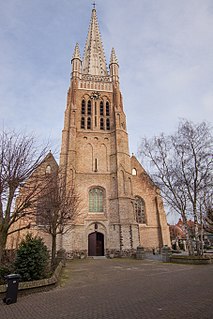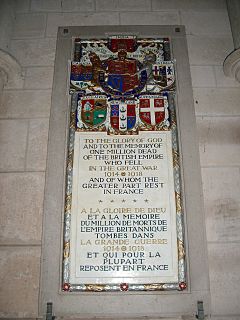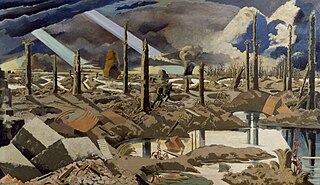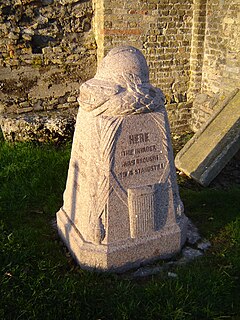Founding members
The founder of the League was a Canadian Ypres veteran, Colonel Beckles Willson. [3] By December 1920, King George V had agreed to become the League's patron. [4] By 1925, there were three patrons: the King, Edward, Prince of Wales and Princess Beatrice. [1] Beatrice, the youngest daughter of Queen Victoria, was herself a mother bereaved by the fighting at Ypres, as her son, Prince Maurice of Battenberg, had been killed in action in 1914 during the First Battle of Ypres. [5] [6]
The League's President, the Earl of Ypres, had been the first commander of the British Expeditionary Force during the war, and presided over one of the League's first committee meetings. [7] Other officials of the League in 1925 included several who had been generals during the war: Earl Haig, Viscount Allenby, Lord Plumer, and Sir William Pulteney Pulteney. The committee also included Viscount Burnham as a representative of the Anglo-Belgian Union. [1]
Memorials and commemoration
Over a quarter of a million men from British and Dominion forces died in the Ypres battles, and one of the League's primary objectives was to establish a lasting memorial to those who fought in the area. In 1924 the League proposed the erection of a memorial church at Ypres. Fundraising by the League led to the building of Saint George's Memorial Church, Ypres, consecrated in 1929. [8] Other memorials established or contributed to by the League included the [[Western Front demarcation stones|Demarcation Stones], a line of 118 red granite pylons marking the line of the Western Front. The League paid for seven of these markers to be erected in the Ypres area. The League also held annual commemorations on 31 October, known as Ypres Day, a date chosen to mark the turning point in the First Battle of Ypres in 1914. [1]
One of the early commemorations of Ypres Day, on 31 October 1921, saw a group of 800 pilgrims organised by the League travelling to Ypres. [9] The tenth anniversary of the League was marked in 1930 by a parade that included Princess Beatrice laying a wreath at the Cenotaph. [10] The wreath-laying at the Cenotaph by Princess Beatrice was repeated in 1935 to mark the League's 15th anniversary. [11]
Publications and services
The League's publications included a quarterly newsletter, The Ypres Times (first published in October 1921, and still being published as late as 1938), [12] and books such as The Immortal Salient (1925), a historical record of the battles and a guide for pilgrims to Ypres. An account of the horror of the conditions on the Ypres Salient, written by the war correspondent Philip Gibbs, was used for the League's information leaflets. Planned publications included the Ypres Book of Valour. [1] The League also had a marching song, called Tramping along to a little tin whistle and an old toy drum, a version of which was published in 1926. [13]
Other services offered by the League included framed certificates of membership for veterans of the conflict and bereaved relatives of the dead. The scroll certificates, designed by Bernard Partridge, were intended as a memorial of honour. The League, together with the St Barnabas Society, also established and maintained a Pilgrimage Centre and rest room at Ypres, and raised funds to help bereaved and impoverished relatives of dead soldiers to visit Ypres and the surrounding battlefields. The League also worked with the Imperial War Graves Commission to compile registers of those buried or lost in the Salient, and to establish historical records and information for pilgrims and its members. [1]
Membership of the League was offered on either a life or annual basis, with reduced and junior fees also available. [1]

Ypres is a Belgian municipality in the province of West Flanders. Though the Dutch Ieper is the official name, the city's French name Ypres is most commonly used in English. The municipality comprises the city of Ypres and the villages of Boezinge, Brielen, Dikkebus, Elverdinge, Hollebeke, Sint-Jan, Vlamertinge, Voormezele, Zillebeke, and Zuidschote. Together, they are home to about 34,900 inhabitants.

Zonnebeke is a municipality located in the Belgian province of West Flanders. The municipality comprises the villages of Beselare, Gheluvelt, Passendale, Zandvoorde and Zonnebeke proper. On January 1, 2006, Zonnebeke had a total population of 11,758. The total area is 67.57 km² which gives a population density of 174 inhabitants per km².

The Menin Gate Memorial to the Missing is a war memorial in Ypres, Belgium, dedicated to the British and Commonwealth soldiers who were killed in the Ypres Salient of World War I and whose graves are unknown. The memorial is located at the eastern exit of the town and marks the starting point for one of the main roads out of the town that led Allied soldiers to the front line. Designed by Sir Reginald Blomfield and built by the Imperial War Graves Commission, the Menin Gate Memorial was unveiled on 24 July 1927.

The German war cemetery of Langemark is near the village of Langemark, part of the municipality of Langemark-Poelkapelle, in the Belgian province of West Flanders. More than 44,000 soldiers are buried here. The village was the scene of the first gas attacks by the German army in the western front, marking the beginning of the Second Battle of Ypres in April 1915.

Tyne Cot Commonwealth War Graves Cemetery and Memorial to the Missing is a Commonwealth War Graves Commission (CWGC) burial ground for the dead of the First World War in the Ypres Salient on the Western Front. It is the largest cemetery for Commonwealth forces in the world, for any war. The cemetery and its surrounding memorial are located outside Passchendale, near Zonnebeke in Belgium.

The St. Julien Memorial is a Canadian war memorial and small commemorative park located in the village of Saint-Julien, Langemark, Belgium. The memorial commemorates the Canadian First Division's participation in the Second Battle of Ypres of World War I which included fighting in the face of the first poison gas attacks along the Western Front. Frederick Chapman Clemesha's sculpture, the Brooding Soldier, was selected to serve as the central feature of the monument following a design competition organized by the Canadian Battlefield Monument Commission in 1920.
The Ypres Salient around Ypres in Belgium was the scene of several battles and an extremely important part of the Western front during the First World War.

The Passchendaele Canadian Memorial is a Canadian war memorial that commemorates the actions of the Canadian Corps in the Second Battle of Passchendaele of World War I. The memorial is located on the former site of Crest Farm, an objective captured by the 4th Canadian Division during the assault of 30 October 1917.

The Canadian Hill 62 Memorial is a war memorial that commemorates the actions of the Canadian Corps in defending the southern stretches of the Ypres Salient between April and August 1916 including actions in battle at the St Eloi Craters, Hill 62, Mount Sorrel and Sanctuary Wood. These battles marked the first occasion in which Canadian divisions engaged in planned offensive operations during World War I. In those actions the Canadians reconquered vital high-ground positions that denied the Germans a commanding view of the town of Ypres itself.

Ramparts Cemetery is a Commonwealth War Graves Commission (CWGC) burial ground for the dead of the First World War located in the Ypres Salient on the Western Front.

Boezinge is a village north of the city of Ypres in West Flanders, Belgium, on the N369 road in the direction of Diksmuide.

"The King's Pilgrimage" is a poem and book about the journey made by King George V in May 1922 to visit the World War I cemeteries and memorials being constructed at the time in France and Belgium by the Imperial War Graves Commission. This journey was part of the wider pilgrimage movement that saw tens of thousands of bereaved relatives from the United Kingdom and the Empire visit the battlefields of the Great War in the years that followed the Armistice. The poem was written by the British author and poet Rudyard Kipling, while the text in the book is attributed to the Australian journalist and author Frank Fox. Aspects of the pilgrimage were also described by Kipling within the short story "The Debt" (1930).

Hooge is a small village on the Bellewaerde Ridge, about 4 kilometres east of Ypres in the Flemish province of West-Vlaanderen in Belgium. Hooge and the nearby locations of Bellewaerde and Zillebeke were merged into Ypres in 1976. The economy of Hooge is dominated by tourism and agriculture. Tourists are attracted by the World War I battlefields as well as Bellewaerde, the oldest operating theme park in Belgium.

World War I memorials commemorate the events and the casualties of World War I. These war memorials include civic memorials, larger national monuments, war cemeteries, private memorials and a range of utilitarian designs such as halls and parks, dedicated to remembering those involved in the conflict. Huge numbers of memorials were built in the 1920s and 1930s, with around 176,000 erected in France alone. This was a new social phenomenon and marked a major cultural shift in how nations commemorated conflicts. Interest in World War I and its memorials faded after World War II, and did not increase again until the 1980s and 1990s, which saw the renovation of many existing memorials and the opening of new sites. Visitor numbers at many memorials increased significantly, while major national and civic memorials continue to be used for annual ceremonies remembering the war.

Between 1923 and 1936, the Imperial War Graves Commission erected a series of memorial tablets in French and Belgian cathedrals to commemorate the British Empire dead of the First World War. The tablets were erected in towns in which British Army or Empire troops had been quartered.

The Menin Road is a large oil painting by Paul Nash completed in 1919 that depicts a First World War battlefield. Nash was commissioned by the British War Memorials Committee to paint a battlefield scene for the proposed national Hall of Remembrance. The painting is considered one of the most iconic images of the First World War and is held by the Imperial War Museum.

In World War I, the area around Hooge on Bellewaerde Ridge, about 2.5 mi (4 km) east of Ypres in Flanders in Belgium, was one of the easternmost sectors of the Ypres Salient and was the site of much fighting between German and Allied forces.

Hill 60 is a World War I battlefield memorial site and park in the Zwarteleen area of Zillebeke south of Ypres, Belgium. It is located about 4.6 kilometres (2.9 mi) from the centre of Ypres and directly on the railway line to Comines. Before World War I the hill was known locally as Côte des Amants. The site comprises two areas of raised land separated by the railway line; the northern area was known by soldiers as Hill 60 while the southern part was known as The Caterpillar.

Western Front demarcation stones, also known as Bornes du Front and Bornes Vauthier, are monuments erected in France and Belgium to mark the limit of the German advance during the First World War. The stones were the idea of sculptor Paul Moreau-Vauthier, a veteran of the war, and were erected between 1921 and 1930. The total number of stones erected is unclear but it is thought that there were 118 official stones, of which 93 survive. The stones identify the army that held that sector in 1918 and are engraved with the text "Here the invader was brought to a standstill 1918" in English, Dutch, and French.


















